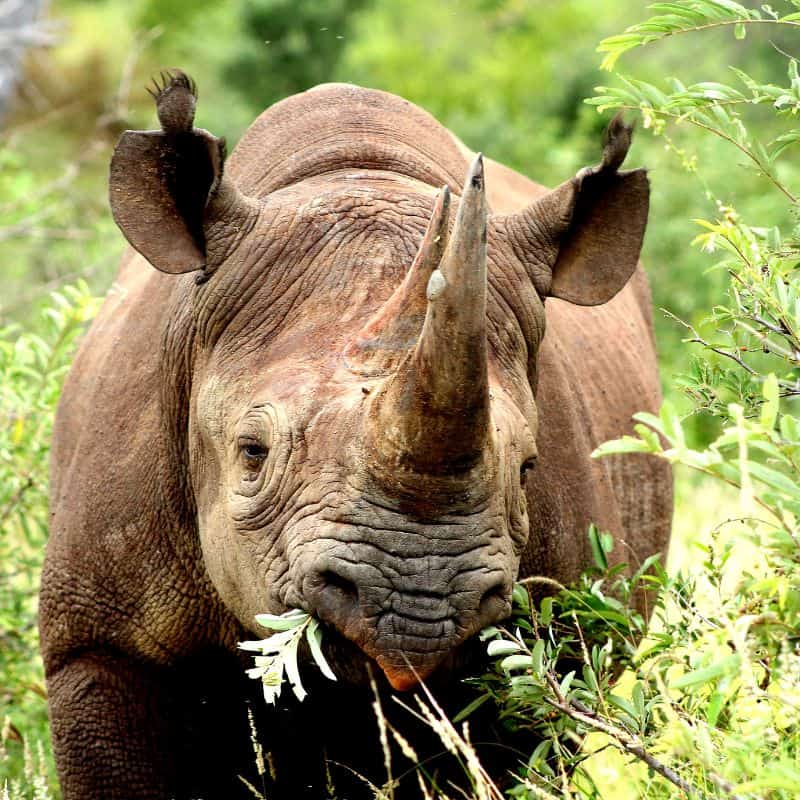Rhinos are the second largest land mammals in the world, and with such a huge size comes a hunger to match. What do rhinos eat then that allows them to maintain such a massive size?
Rhinos eat grass, twigs, branches, foliage, aquatic plants, and fruit, depending on the species. Black, Javan, and Sumatran rhinos feed on twigs, branches, and foliage, while White and Indian rhinos eat grass. The Indian Rhino also eats aquatic plants and occasionally fruit.
Let’s look further at the rhinoceros diet to see how and why these animals eat what they do.

What Do Rhinos Eat: Browsers vs. Grazers
First things first, rhinos are strictly herbivorous. And they eat a lot.
It’s estimated that a black rhino eats up to 2.5% of its body weight daily, but it all comes from a plant-based diet.
In the wild, rhinos’ diets could range between grass, fruits, leaves, and twigs, depending on the species.
As it turns out, not all rhinos are created equal; some are browsers, while others are grazers.
Let’s break that down:
Browser Rhinos
Being a browser means the rhino’s snout can handle more than just grass and leaves. For instance, the black rhino’s prehensile lip could grab twigs, much like our opposable thumbs.
Plus, the long lips allow the rhino to reach the foliage or fruit above eye level on trees.
Grazer Rhinos
Unlike browsers, grazers have square, broad lips that can sit nearly flush to the ground level when the rhinos lower their head to eat. This way, they can nibble on even the shortest grasses.
However, it also makes eating twigs and branches much harder. So, for the most part, they’ll just stick to grazing from the ground.

What Do Different Types of Rhinos Eat?
Now that we know that rhinos could be browsers or grazers let’s look closely at each species’ eating habits.
Black Rhino
The black (Diceros bicornis) rhino is perhaps the most common browser.
The species is sometimes even called the hook-lipped rhino since they can easily feed on twigs, shoots, or even thorns.
White Rhino
If black rhinos are a prominent example of browsers, then the white Ceratotherium simum is the number one grazing rhino species.
White rhinos spend a considerable portion of their days eating. An adult could eat up to 120 pounds in a single day.
Indian Rhino
The Indian (Rhinoceros unicornis) species also falls under the grazer category. However, unlike the white rhinoceros, these have a single horn instead of two. That’s why they’re also called the greater one-horned rhinos.
What sets them apart in terms of diet is that they eat aquatic plants.
Javan Rhino
Javan (Rhinoceros sondaicus) rhino species is so critically endangered that getting a sighting is extremely rare.
These rare rhinos are browsers requiring around 110 pounds daily.
Sumatran Rhino
The Sumatran rhino (Dicerorhinus sumatrensis) is the smallest browser rhinoceros, and they are known to have a craving for mangoes and figs.
Aside from their sweet tooth, they also need salt licks around springs or mud for nutrition and tracking mating partners’ scent marks.
How Do Rhinos Digest Their Plant-Based Diets?
We know that different species have snouts and lip shapes adapted to the ideal diets for their habitat, but how do rhinos handle being herbivorous in the first place?
The cellulose in fibrous green leaves and foliage isn’t exactly the easiest thing to digest. That’s why some animals that rely so heavily on grass, like cows or giraffes, have ruminant digestive systems with multiple compartments.
However, that’s not the case with the rhino.
Rhinos are monogastric herbivores with undivided stomachs. Yet, they have a large caecum full of helpful microbes that help them break down the heavy plant tissues through fermentation.

3 Things That Affect the Typical Rhinoceros Diet
Rhinos might have preferences, but their diets could change for many reasons, from resource scarcity to weaning phases.
Here are a few factors that can affect what these stocky animals get to eat:
1. Captivity vs. Wilderness
Since rhinos eat a lot, their diets in captivity are mostly supplemented with alfalfa and commercial pellets with soy.
Sure, that’s practical when you look at it from a financial standpoint. However, it doesn’t mimic the diversity that they get from their natural eating habits.
Researchers even point out that the phytoestrogen levels in this kind of diet might be behind the fertility problems often noticed in female white rhinos in captivity.
2. Maturity and Nursing
As calves, rhinos might try to mimic their mothers’ eating patterns and feed on grass or foliage. Yet, their primary source of nutrition for the first few months should always be milk.
So, if a baby rhino gets rejected or separated from his nursing mother at a young age, the caretakers will need an external replacement with low-fat and high-carbohydrate portions.
After all, the rhino’s milk is one of the most skimmed varieties in the animal kingdom at a mere 0.2% fat proportion.
3. Seasons and Habitat
The regular diet might shift slightly to make room for seasonal fruits, depending on where the rhino lives and the time of year.
For instance, the Trewia fruits could become an important nutritional source for Nepal’s greater one-horned rhino population between June and October.
On the other hand, when things get scarce, rhinos eat what they can find and look for hydration within the sap of trees.
Final Thoughts on the Rhino Diet
All rhino species are herbivorous, but their diet changes depending on how their lip shape is adapted to their environment.
The browsing rhinos are the black, Javan, and Sumatran species, so they feed on twigs, branches, and foliage.
Meanwhile, the grazing white rhino feeds on grass, and the greater one-horned rhino also feeds on grass, but they can also eat aquatic plants and some seasonal fruit.
We hope this article has helped shed some light on how these animals can sustain their massive bodies.
